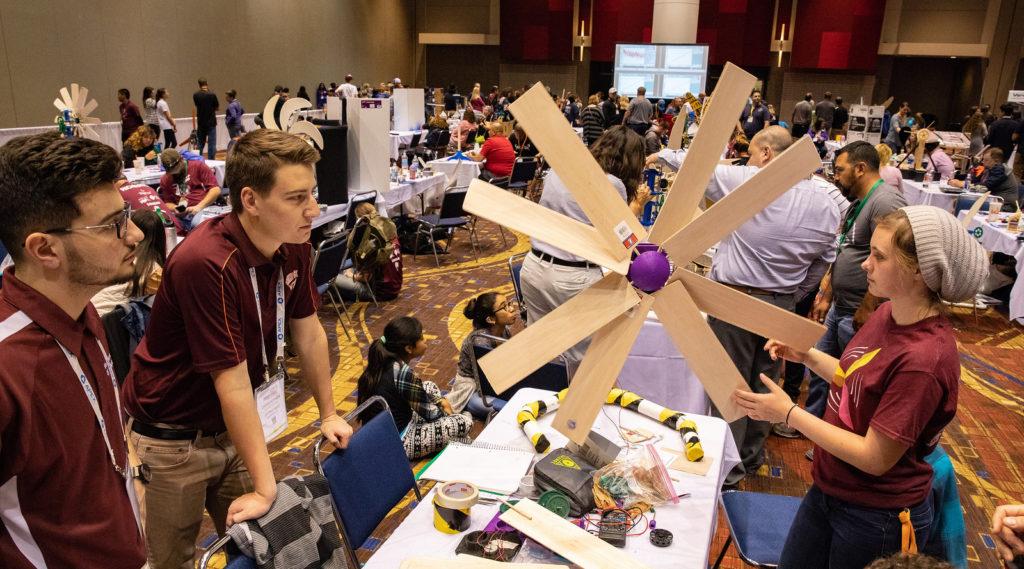
Sharing ideas and inspiration for engagement, inclusion, and excellence in STEM

Whether you are a K–12 or college educator, KidWind offers a versatile, affordable way to teach the science of renewable energy—and that’s just the start.
With KidWind, students build wind turbines and work with solar panels. In the process, they sharpen their engineering design skills, engage in critical thinking, and develop creative solutions to problems.
Today, Vernier manufactures all KidWind products, from gears to wind tunnels. We also offer multiple lab books focused on renewable energy.
Additionally, Vernier has developed energy sensors to provide an easy way to quantify voltage, current, power, and energy output of small wind turbines and solar panels, such as those used in our KidWind Experiment Kits.
Preparing Students for the Renewable Energy Jobs of the Future
According to Michael Arquin, founder and director of KidWind, teaching students about renewable energy offers a variety of benefits.
“First of all, it’s engaging and timely,” Arquin said. “And for K–12 students, it helps them address national science standards, like the NGSS—practices such as inquiry-based experimentation and data analysis.”
In addition, Arquin cites workforce development as a crucial reason to incorporate renewable energy into a science curriculum.
“By some estimates, we’re going to need half a million employees in the renewable energy sector in the next 10 years,” he said. “Where are they going to come from if they’re not exploring it as students? And how are we going to make sure all students have equitable access to renewable energy? The more that we can get this information in front of as many students as possible, the better off we’ll all be.”
Tailoring for Different Grade Levels
Vernier carries a specific line of KidWind equipment, as well as related products, differentiated for
However, with the entire KidWind product line, educators can choose what they want to focus on, making it easily customizable based on students’ interests and grade level.
“What any renewable energy space allows us to do is increase complexity through a systems approach by adding mathematics and more sophisticated physics principles,” Arquin said. “One of the things I love about wind and solar is that they’re infinitely scalable. Some of our activities can be used with fourth graders—and the same exact ones can be used with college students. It just depends on the instructor and the complexity that they want to get into.”

Engaging Mechanical Engineering Students
The Kansas Energy Program, which is housed within the Kansas State University Engineering Extension, delivers energy education to K–12 schools and has partnered with
K-State professors for many years.
David Carter, director of the Kansas Energy Program, said the most notable partnership began in November 2018, when Dr. Kevin Wanklyn asked for assistance with his Introduction to Mechanical Engineering course.
“His idea was to have the students design a wind turbine that produced electricity, could be shipped in a standard FedEx/UPS box, and could be assembled using only picture instructions,” Carter said. “We showed him the Vernier KidWind equipment that we had to offer—a wind tunnel, anemometer, energy sensor, and wind kits—and he was very excited!”
Carter and his team also set up practice wind tunnels for the students, and on the day of testing, they set up and helped Wanklyn run all the student teams through a performance wind tunnel. They continue to support this work; since November 2018, Carter and his team have assisted more than 440 Introduction to Mechanical Engineering students.
Igniting the Creativity of K–12 Students
All KidWind products are designed to help students gain a basic understanding of various renewable energy concepts. These include wind turbine blade design, how a solar panel works, and ways to measure energy output, according to Arquin.
“KidWind materials are scaled to teach first principles, with the idea that students are eventually going to grow out of it and want to build something more complex,” he said. “We really push the idea that we need to build the base but that students will go past it using advanced manufacturing.”
The National KidWind Challenge and regional events give students an opportunity to demonstrate their innovation with KidWind wind turbines outside of the classroom.

“It’s a student-driven competition, but it’s more of a celebration of student achievement,” Arquin said. “What the students come up with, their creativity, all the cool things they do—it’s pretty off the charts.”
One educator, who teaches middle school science in Illinois, described how he and his students were inspired after participating in a recent National KidWind Challenge.
“It was amazing to view such imaginative ingenuity of students and their products from elementary school through college,” the educator said. “Just witnessing the results of so many students’ mindsets to solve problems related to energy generation makes me more hopeful for our future. [KidWind] helps students master essential 21st-century skills and abilities to successfully solve problems we face in energy production and in dealing with the social issues of our time.”
To learn more about the National KidWind Challenge, watch this video of the 2022 event.
To explore the basics of KidWind wind turbine design, check out this Vernier webinar recording.
Share this Article

Sign up for our newsletter
Stay in the loop! Beyond Measure delivers monthly updates on the latest news, ideas, and STEM resources from Vernier.






